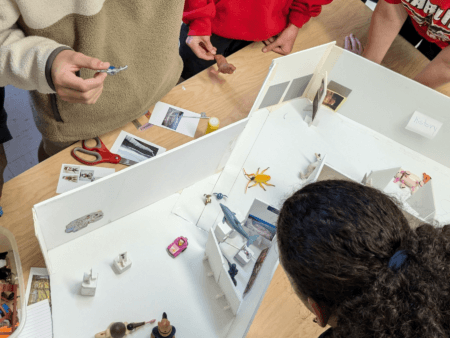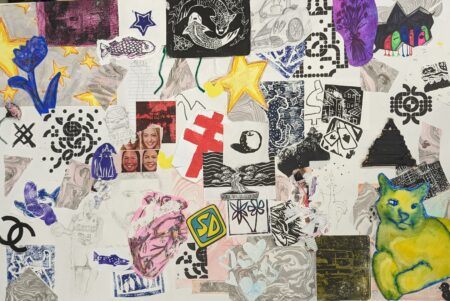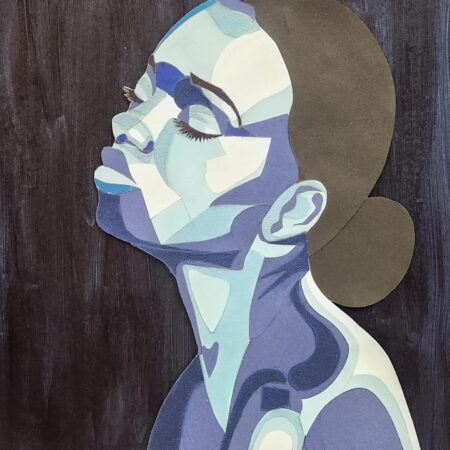Teaching with Contemporary Art
The World is Yours

IMAGE: Production still from the Art21 New York Close Up film, Guadalupe Maravilla & the Sound of Healing. © Art21, Inc. 2021.
The ways in which a young person develops and discovers their identity during adolescence has the potential to define their lives as they continue to grow. As an art educator of young adolescents, I feel a strong pull to provide students with a variety of opportunities to use art at this critical stage of their lives. The social structures of students’ lives are filled with others telling them what to do and what to be. Very rarely are students allowed to define themselves under a student-centered construct. Identity is flexible, always changing and adapting—very much like young adolescents themselves.
Often, adults are the ones that find it hard to allow students to figure out what they want to say about themselves. But I want my classroom to be a space for self-discovery. And so, for the past several years, I have made space in the art classroom for my students to begin tackling the notion of how they see themselves versus how others see them. Through exposure to various forms of contemporary art, stories about contemporary artists, and student-centered dialogue, students have begun challenging the notions of how they are being defined by others, and taking control of their own personal narratives. Through this questioning, learning, and discussing many students find a voice that they may not have realized existed in them before.
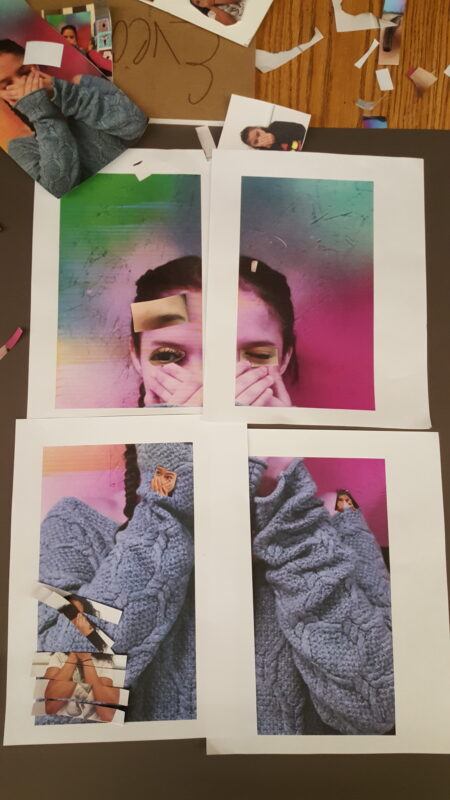
IMAGE: Photo courtesy of Alex Mendez.
I have found that to do this kind of work takes time, careful reflection, and patience on my part as an educator and on the part of the student. Many students have never been asked to make art about how they see themselves or how others see them. As a result of this learned hostility to self-expression, many students only want to stay in a safe space because they may not be comfortable sharing their personal side. Asking students to make art about identity is never easy. Challenging students to deal with themes of identity shows them that they have a voice and they will be listened to.
Contemporary artists are really good at redefining what art is and can be. In some instances, they redefine themselves through the art that they make. Asking students to begin the process of redefining themselves, or to shift thinking around who they are and begin the process of thinking about who they can be, is a great way to converge ideas. This is a pivotal time in their lives; they are only just beginning to understand a portion of what it means. Making sense of this notion will only continue as they leave middle school and move beyond high school, college, and adult life. Identity is always changing, but the amount of time dedicated to that understanding shrinks and shrinks as we get older.
Some of the current artists that I use to help students understand how to address the issues of identity are Brian Jungen, Cindy Sherman, Jean Michel Basquiat, Tommy Kha, and Guadalupe Maravilla.
Brian Jungen uses parts of how he is perceived and how he sees himself to create art that questions roles of identity. He is very aware of how others view him or how others try to put him into specific categories. Using his work with students allows them to see that one does not have to follow the stereotypes placed on you by other people or by society. Other artists like Cindy Sherman have been working with the idea of identity and how it is defined for years. Her media is primarily photography and she controls what is being photographed. She uses herself as the main subject of her work and deals directly with various forms of identity, perception, and ambiguity. These artists are able to experiment with their chosen media to communicate the importance that identity plays in their art.

IMAGE: Production still from Art in the Twenty-First Century Season 8 episode “Vancouver.” © Art21, Inc. 2016.
Guadalupe Maravilla makes art to help heal himself and in turn, helps to heal others. His work is primarily autobiographical and centered around his own experiences related to past trauma. He says that healing isn’t always the easiest thing to do but that healing has its own way of manifesting itself. It looks different for different people at different times. His role in making art becomes more than just for the gallery or museum; it is also for his own personal growth, and to provide other people with a sense of guidance and help.
I realize that many students are hesitant to embrace the idea of delving into their identity and being forthcoming with how they see themselves. Having the option to explore these themes and ideas gives them an opportunity to be heard, seen, and listened to. Even if the reflections are not immediate, experience shows that they will eventually happen. I approach teaching with identity as a way to help adolescents and young adults fight to make a place for themselves in their peer groups, school communities, and families.

IMAGE: Photo courtesy of Alex Mendez.
In the safety of the art classroom, there can be exploration and experimentation that nourishes the adolescent soul. It is not an easy task to talk about yourself and let others inside your deepest thoughts. Over the years I have realized that many students are already thinking about these ideas, and are struggling to find ways to talk about them and express them safely. Having a safe space where these issues and ideas can be sorted and worked through is vital to young lives and future members of society.
There are a couple of things that I do in my classroom to ensure this safe space. I acknowledge where the students are coming from. I make it a point to let them know that they are open to representing themselves how they see fit. I acknowledge that some students have a negative view of themselves and as a class, we discuss how this may or may not be a good idea for a project. I let students know that if they chose to approach their work from this perspective, they must be ready to discuss and share it with their peers. As part of our end-of-project presentations, each student must present their work to a group of 4 to 5 of their peers. This helps to make sure that students do not get overwhelmed with sharing anything personal with a large group, and instead can speak to a smaller group in a more comfortable space. I ask if any student is interested in sharing with the larger group towards the end of the presentations to give students the opportunity to share their work in a larger setting if they feel comfortable. I make it a point to ensure that students are listening to each other during presentations or when talking in front of the whole class. I like to emphasize that each student must listen and be respectful to each other. I also meet regularly with each student during the project creation process to check in with them and see how they are navigating their ideas.
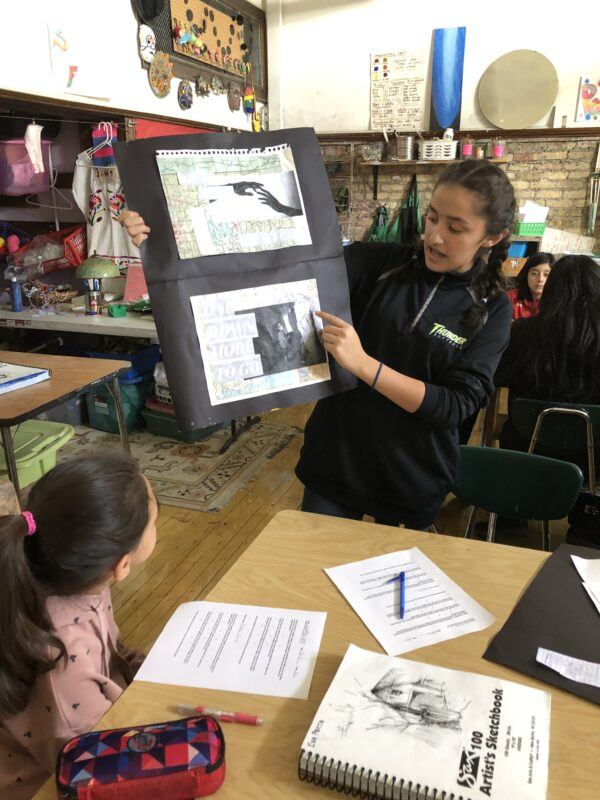
IMAGE: Photo courtesy of Alex Mendez.
Using art and contemporary art ideas to talk about the personal can be empowering. I have seen whole classrooms cry together because of the personal stories they have chosen to share with each other. It is a powerful experience. Witnessing a classroom of 30 teenagers open up about their trauma and healing can be staggering and overwhelming. More significantly, it creates opportunities for other students to respond to their honesty and vulnerability with kindness and compassion. In one instance, several students chose to present their work to the entire class and started getting emotional throughout their presentation. Their peers gave them words of encouragement and support. This helped other students make the decision to share their own experiences. Being open to letting students’ voices come through shows students that making art is about something more than an aesthetic or commodity. It can be a way of life—a method of building community and connection and understanding oneself. To be able to take control of how that story gets told from your own perspective and your own voice can be uplifting. The narrative is yours alone and can change and move as one grows in life. I hope that these opportunities continue to present themselves for adolescents and young adults.

IMAGE: Production still from the Art21 “New York Close Up” film, “Tommy Kha’s Bits and Pieces.” © Art21, Inc. 2022.
Throughout the years of teaching with the theme of identity, I have learned that having faith and trust in young people can be both rewarding and challenging, oftentimes simultaneously. Asking students to push their thinking and experiment with ideas related to who they are or who they want to be can sometimes bring up memories that they may not want to relive. This is a delicate balance to be maneuvered in order to make sure students know that their voices matter, and also to create a safe space in the classroom to explore these ideas through art. It is during these explorations that I see authentic artistic expression from my students. A bond of understanding is developed with their peers and anyone who participates in the making, learning, and sharing experiences in the art room. For some of my students, they may never have the opportunity to feel safe enough to talk openly about who they are and who they want to become. They may not feel comfortable discussing how the world sees them or tries to define them. My goal is never to push them beyond what they feel comfortable with, but simply to ensure that they come away with the ability to question their experiences and gain a sense of power over who they want to be in this world. I hope that contemporary art is the gateway for their own self-discovery, exploration, and voice.

